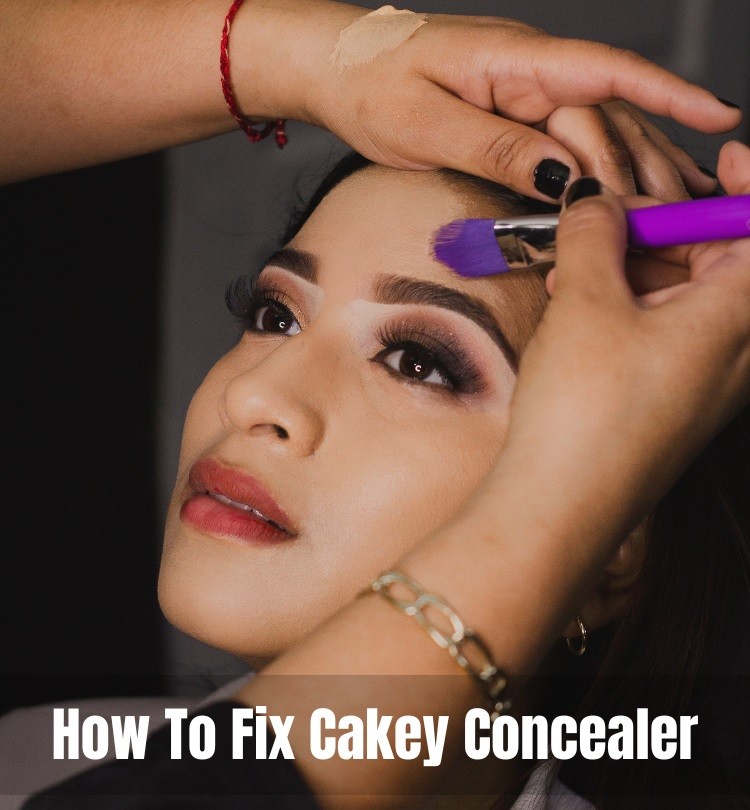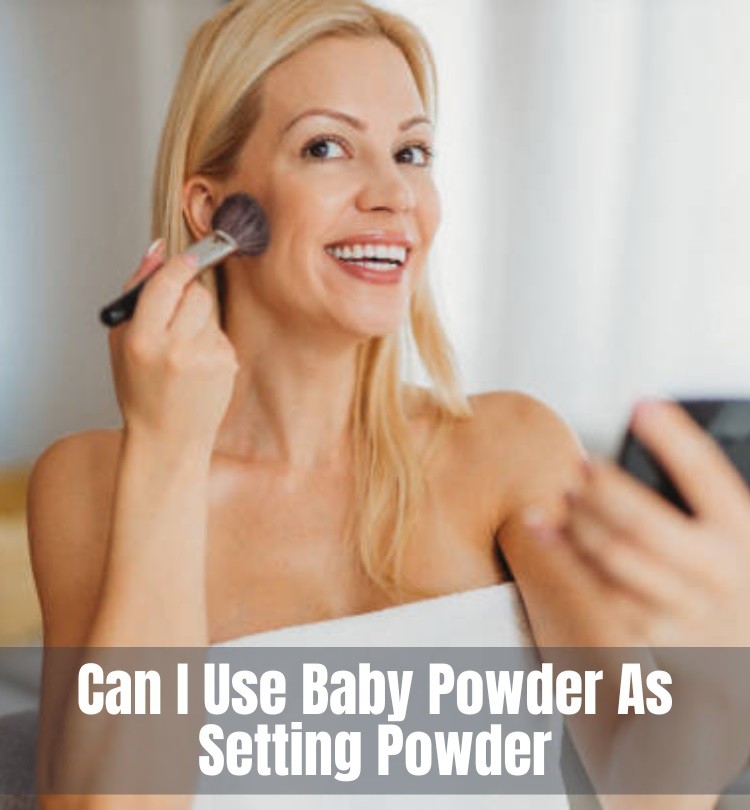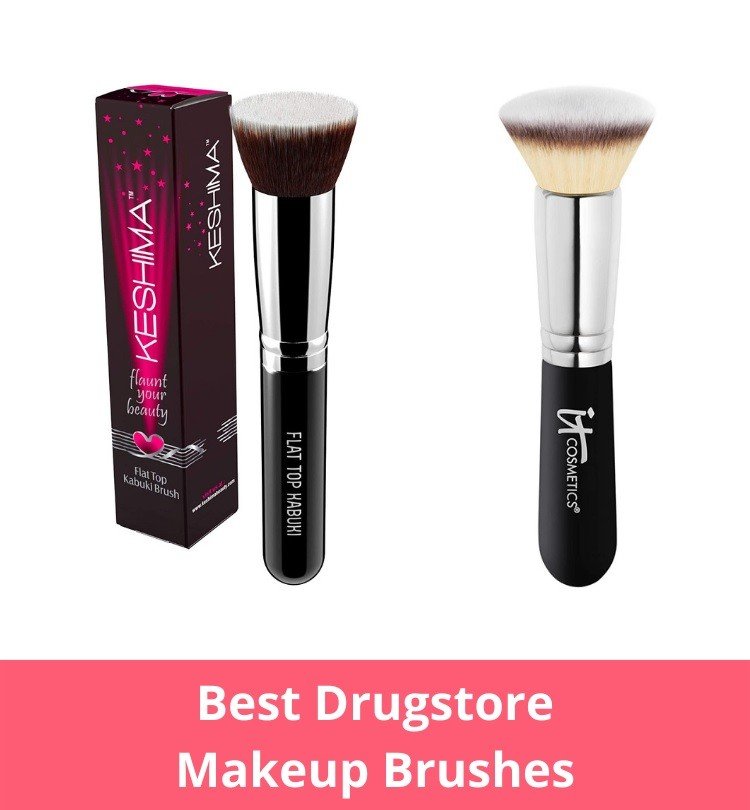This post contains affiliate links.
Updated on March 8, 2025
To fix cakey concealer, blend it properly and apply thin layers. To achieve a flawless finish, use a damp makeup sponge or a small brush and gently buff the concealer in a circular motion, building up the coverage gradually.
Cakey concealer can be a real nightmare for any makeup lover. No matter how hard we try, sometimes we end up with a flaky or rough-looking finish. Whether you have dry or oily skin, cakey concealer can happen to anyone.
But, worry not, as there are ways to fix it and achieve a smoother and more flawless look. We’ll explore the reasons that cause cakey concealer and then delve into some simple yet effective ways to fix it. From choosing the right product to applying it correctly, we’ll cover all you need to know to fix cakey concealer and get that flawless look.
Contents
Understanding Cakey Concealer And Its Causes

Definition Of Cakey Concealer
Cakey concealer is a term used to describe a finish that looks thick, dry, and not seamless on your skin. Your concealer should help you cover any imperfections to create a flawless complexion. If your concealer looks cakey, it can emphasize your creases and age you.
Related: Should My Concealer Be A Lighter Shade Than My Foundation?
Common Mistakes That Lead To A Cakey Finish
The following are common mistakes that can lead to a cakey finish:
- Using too much concealer can lead to cakey and unnatural-looking skin.
- Applying your concealer over dry or flaky skin can worsen the cakey look.
- Using powder-based products can lead to a cakey finish, especially on drier skin types.
Factors That Contribute To Cakey Concealer (E.G. Skin Type, Application Method, Product Formula)
Several factors contribute to cakey concealer, and these include:
- Skin type: Depending on your skin type, certain concealers may not work best. For example, a matte formula can emphasize dry patches on drier skin while an oil-based formula may cause creasing on oilier skin types.
- Application method: Using your fingers can cause the concealer to melt and settle into your fine lines and wrinkles, leading to a cakey finish. Using a concealer brush or blending sponge can help you create a more seamless finish.
- Product formula: Avoid using products that contain ingredients that can be too drying for your skin type as they can emphasize your skin’s texture. A water-based concealer can help you create a more natural-looking finish.
By understanding the causes of cakey concealer and modifying your skin care techniques, you can achieve a flawless and natural look that enhances your natural beauty.
Preparing Your Skin For Concealer Application
A cakey concealer can be a real pain, making your under-eye area look dry and patchy. It’s not always the concealer to blame; the condition of your skin is equally important. Therefore, before you blame your concealer for not giving you a flawless look, try prepping your skin with these simple tips.
Cleansing And Moisturizing Tips To Avoid Cakey Concealer
Clean and hydrated skin is the key to a flawless concealer application. Here are some cleansing and moisturizing tips to avoid cakey concealer.
- Begin by removing all traces of makeup from your face using a gentle makeup remover.
- Follow up with a suitable cleanser that’s gentle on your skin. Opt for a cleanser that suits your skin type.
- Rinse thoroughly with lukewarm water.
- Pat dry your face with a towel.
- Apply a lightweight moisturizer that works for your skin type. Ensure that you allow enough time for the skin to absorb the moisturizer fully.
How To Prime Your Skin For Better Concealer Application?
The right primer can make all the difference when it comes to applying concealer. Here’s how to prime your skin for a better concealer application.
- Choose a primer that suits your skin type.
- Squeeze out a pea-sized amount of primer on your fingers and apply it all over your face.
- Wait for a minute or two for the primer to settle down and allow it to create a smooth and even base for your concealer application.
- Once the primer has been set, you can apply your concealer for that perfect coverage.
Importance Of Exfoliating And Hydrating The Under-Eye Area
Your under-eye area is often the first to show signs of aging, dryness and fatigue. Hence, it’s essential to take good care of it. Follow these tips to keep your under-eye area hydrated and exfoliated to avoid cakey concealer.
- Exfoliate your under-eye area once a week to remove dead skin cells and improve circulation.
- Use an eye cream or serum that’s specifically formulated to hydrate the under-eye area.
- Apply a moisturizing eye mask or patch before applying your concealer.
- Lastly, dab some eye drops if you feel your eyes are dry, as it can help to refresh and brighten up your under-eye area.
Remember, a cakey concealer is preventable with the right skincare routine. Ensure you cleanse, moisturize, prime and take care of your skin to achieve that flawless look.
Related: Does Baby Oil Help You Tan?
Choosing The Right Concealer For Your Skin Type

Understanding Your Skin Tone And Undertone
Choosing the right concealer for your skin type can be challenging. Skin tone and undertone play a significant role in finding the perfect shade. Here are some key points you should know:
- Skin tone: Determines the color of your skin. It is classified into fair, light, medium, tan, and deep.
- Undertone: Refers to the color that appears underneath your skin’s surface. It can be cool, warm, or neutral.
When choosing a concealer, you need to determine both your skin tone and undertone. The right concealer should blend seamlessly and match your skin, creating a natural look.
Different Types Of Concealer Formulas And Their Application Techniques
Concealers come in various formulas, and each serves a specific purpose. Below are some common types and their recommended application techniques:
- Liquid concealer: Ideal for a natural finish. Apply dots under your eyes or any blemishes and blend with a brush or finger.
- Cream concealer: Provides more coverage and is recommended for those with dry skin. Apply with a small brush or a sponge and blend gently.
- Stick concealer: Great for touch-ups during the day. Apply dots on the desired area and blend with your fingers.
Ensure the concealer’s consistency is smooth and applied evenly to avoid caking or settling into fine lines.
Ways To Choose Your Correct Shade Of Concealer
Selecting the right color concealer can be overwhelming, but it is essential for a natural-looking finish that blends perfectly with your skin tone. Here are some tips to help you choose the right shade:
- Determine your skin tone and undertone before selecting your concealer shade.
- Choose a color that is one or two shades lighter than your complexion to brighten up your under-eye area.
- If you want to conceal blemishes or dark spots, select a shade that matches your skin tone exactly.
- Always test the concealer on your jawline or neck to ensure it matches your skin tone in natural light.
By following these steps, you can rest assured that you are selecting the right shade that will enhance your beautiful skin.
Application Techniques For A Smooth, Flawless Finish
Applying Concealer With A Brush, Sponge, Or Fingers
Choosing the right application tool can make all the difference in achieving a smooth and even concealer application. Here are some key points to bear in mind:
- A brush can offer the most precise application, allowing you to target small areas with control. Opt for a flat, densely packed brush for the best results.
- A sponge can help you achieve a natural, airbrushed finish. Saturate the sponge with water before use for a smoother application.
- Using your fingers can be convenient and quick, as the warmth of your skin can help blend the product seamlessly. It can be challenging to achieve precise application in hard-to-reach spots.
Layering Techniques For Fuller Coverage Without Cakiness
Layering your concealer correctly can help decrease cakey texture without compromising coverage. Here are some tips to follow:
- Start with a thin layer of concealer, focusing on small areas at a time.
- Blend the product well, ensuring that there are no harsh edges.
- If necessary, build up coverage gradually rather than applying too much product at once.
- Consider using a color corrector under your concealer if you have dark under-eye circles or stubborn blemishes.
How To Blend Concealer With Other Makeup Products
Blending concealer with other makeup products can help achieve a seamless finish that doesn’t look cakey. Here are some suggestions:
- Mix concealer with moisturizer or primer to create a natural and sheer finish.
- Use a beauty blender to blend concealer with a foundation for a seamless base.
- Set the concealer with a translucent powder to protect it from creasing.
By following these application techniques, you will be well on your way to a smooth, flawless finish with your concealer. Experiment with different methods until you find what works best for you.
Related: Does Coconut Oil Help You Tan?
Fixing Cakey Concealer On The Go
Cakey concealer can be frustrating, and it can be particularly challenging when you’re in a hurry. Luckily, there are a few ways to fix cakey concealer on the go. Here are the quick fixes for cakey concealers throughout the day with the subheading title: fixing cakey concealer on the go.
Quick Fixes For Cakey Concealers Throughout The Day
- Use a facial mist: Spritzing a facial mist can help refresh your makeup and give it a dewy look. It can also help break down some of the excess product that’s causing your concealer to look cakey.
- Use a light moisturizer: Applying a small amount of moisturizer to the cakey spots can help soften them and help the concealer look smoother. Ensure to avoid any areas where you don’t want added shine.
- Use a Q-tip soaked in micellar water: The micellar water can help break down excess product and won’t mess up the rest of your makeup if you use a Q-tip.
- Use a damp beauty sponge to blend your concealer: Wetting your beauty sponge and lightly tapping it over the cakey sections can help smooth them out.
How To Touch Up Your Concealer Without Ruining The Rest Of Your Makeup?
- Use a clean brush or beauty sponge: Use a brush or sponge to add a small amount of concealer to the cakey areas. Make sure it blends seamlessly.
- Set with powder: Using a tiny amount of setting powder in the cakey areas can help soak up excess product and give the concealer a more natural finish.
- Avoid layering: Instead of applying lots of layers of concealer, try to use less product in the first place.
- Always keep a mirror: Always carry a pocket mirror to check on the cakey spots on your face and touch up any areas.
Products That Can Help Revive Cakey Concealer
- Makeup setting spray: Using a setting spray can help refresh your makeup and give your skin a dewy finish.
- Hydrating primer: Using a hydrating primer before your concealer can help you avoid cakey spots in the first place.
- Corrector: If you have very dark under-eye circles, consider using a corrector in a color that complements your skin tone to lighten them.
Remember, cakey concealer can be a challenge, but armed with these tips and tricks, you should be able to fix it easily. Keep in mind that less is often more when it comes to concealer, so try to apply a small amount and blend it out to avoid cakey spots.
With a little bit of practice, you’ll be looking flawless in no time!
Frequently Asked Questions On How To Fix Cakey Concealer?

What Causes Cakey Concealer?
Cakey concealer can be caused by using too much product, not blending well, or applying concealer on dry skin.
How Do You Prevent Cakey Concealer?
To prevent cakey concealer, use a hydrating eye cream, blend with a damp beauty sponge, and set with a small amount of powder.
How Can You Fix Cakey Concealer?
You can fix cakey concealer by using a clean brush to gently buff out any excess product and adding a small amount of setting spray.
Can You Use Oil To Fix Cakey Concealer?
Yes, you can use a small amount of facial oil to fix cakey concealer. Apply a drop to your finger and smooth over the affected area.
What Is The Best Concealer For Preventing Cakey Coverage?
Creamy, hydrating concealers work best in preventing cakey coverage. Look for products with moisturizing ingredients like hyaluronic acid or glycerin.
Conclusion
After all, cakey concealer is not a problem that can’t be fixed. It is essential to know the right techniques and products so that you can achieve flawless, natural-looking skin. Remember to prep your skin before applying concealer, use the right amount, blend effectively, and set it with a powder.
Always choose the right shade for your skin tone and the type of concealer that suits your skin to avoid exacerbating the cakey appearance. Lastly, don’t be afraid to experiment and try out different techniques until you find the perfect one for you.
With these tips and tricks, you can say goodbye to cakey concealer and hello to a flawless, even complexion. Happy concealing!




